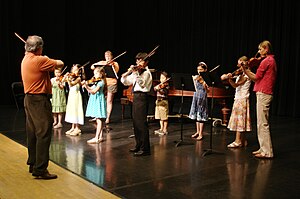http://www.arteducators.org/
http://artsusa.org/networks/arts_education/default.asp
http://www.yea.org/
http://www.ijea.org/
http://artsusa.org/networks/arts_education/default.asp
http://www.yea.org/
http://www.ijea.org/
I also thought about people I knew. Being a music minor, I have had contact with some professors in the music department. Here are a couple of them:
Luke Howard
Eric Hansen
Claudine Bigelow
I also did a search on Google+ in order to find thought leaders without much success. So I used the library to find a book and used that to find people.
 All of the following sources talk about the arts. They talk about how the arts are being affected by technology or using technology to measure the effects of the arts. And most of them relate this to education.
All of the following sources talk about the arts. They talk about how the arts are being affected by technology or using technology to measure the effects of the arts. And most of them relate this to education.
 All of the following sources talk about the arts. They talk about how the arts are being affected by technology or using technology to measure the effects of the arts. And most of them relate this to education.
All of the following sources talk about the arts. They talk about how the arts are being affected by technology or using technology to measure the effects of the arts. And most of them relate this to education.
Further Reading:
Cayari, Christopher. (The YouTube Effect: How YouTube Has Provided New Ways to Consume, Create, and Share Music, International Journal of Education & the Arts, 2011). Follows the case study of a young musician and how his career develops through the new technological outlets available. Explores the changes to the music industry by Youtube and how it is and can be used in the classroom promoting the idea that technology can help resurrect the arts. [This article was found through a search on the International Journal of Education and the Arts (IJEA) website].
Hyde, Krista and Jason Lerch. (Musical Training Shapes Structural Brain Development, The Journal of Neuroscience, 2009). Presents research done on a set of young students at Boston Public Schools that studies brain development for musically trained students versus non-musically trained students. The study finds that after just 15 months there are significant results, which supports the argument that the arts are useful for all students. [This journal article was found through a Google scholar search].
Bresler, Liora. (International Handbook of Research in Arts Education, Springer, 2007). Contains a whole technology section with 7 different articles referring to arts in general, and in particular like music, visual arts, and dance. All of the articles in the technology section support the argument that technology supports arts education. [This book was found in the Harold B. Lee Library].
Thought Leaders:
Ilana Snyder (Digital Literacy: What it Means for Arts Education, Springer, 2007). Snyder, a research out of Monash University in Australia, plays a large role in advocating digital literacy, which is applicable to all parts of the ebook but especially the arts. [She was found through her article in the International Handbook of Research in Arts Education].
Peter Webster (Computer-based technology and music teaching and learning, Springer, 2007). Webster, a professor of music education and technology at Northwestern University and editor of many music education journals, has published many papers about music, education, and technology. His writings support that the three can not only coexist but even support one another. [He was found through his article in the International Handbook of Research in Arts Education].
Mila Parrish (Technology in Dance Education, Springer, 2007). Parrish investigates the use of videoconferencing to Mila has served on the board of the National Dance Education Organization (NDEO) as the Director of Technology, Dance and on the Child International (daCi) as the Newsletter Editor, and the Dance Notation Bureau (DNB). She started a program called iDance SC, that uses videoconferencing to meet the needs from at-risk and low-performing schools. Her revolutionary incorporation of dance and technology is exactly what the arts chapter is about. [She was found through her article in the International Handbook of Research in Arts Education].





No comments:
Post a Comment